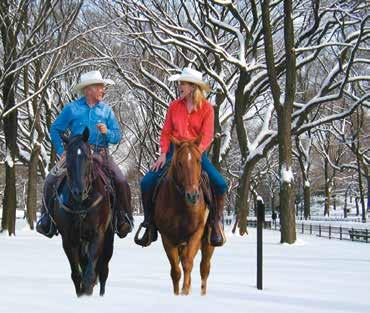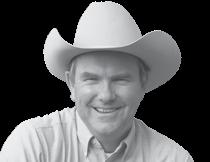
25 minute read
used in Wyoming
Submit your events to: Editor, Wyoming Livestock Roundup, P.O. Box 850, Casper, WY, 82602, or e-mail to roundup@wylr.net.
Dec. 3-12
Advertisement
Dec. 9-10
CANCELED
Dec. 24-Jan. 1
Jan. 11-12
Jan. 13-14
Feb. 15-18
EVENTS
Wrangler National Finals Rodeo, Arlington, Texas, Globe Life Field. For more information, visit nfrexperience.com/nfr2020/.
Wyoming Stock Growers Association 2020 Winter Roundup Conven-
tion and Trade Show, Casper, Ramkota Hotel and Conference Center. For more information, visit wysga.org. Natrona County Predator Management District 2020 Annual Meeting, 4 p.m. Teleconference. To join the meeting, call 605-313-6272 using the access code 553517.
Wyoming Game and Fish Department Platte Valley Corridor Public
Meeting. Online. For more information, visit wgfd.wyo.gov/Get-Involved/ Platte-Valley-Migration-Risk-Assessment.
Wyoming Legislature Select Federal Natural Resource Funding Com-
mittee Meeting, 8:30 a.m. Online. For more information or to livestream the meeting, visit wyoleg.gov.
Wyoming Legislature Joint Travel, Recreation, Wildlife and Cul-
tural Resources Meeting, 8:30 a.m. Online. For more information or to livestream the meeting, visit wyoleg.gov. Wyoming Water Development Commission Workshop and Meeting. Google Meet. For more information, visit wwdc.state.wy.us/.
The Jonah Interagency Office and Pinedale Anticline Project Office
Board of Directors Meeting, Zoom. For more information, visit blm. zoomgov.com/webinar/register/WN_kNvHiZRBRgKm1u4X-HQR_Q. Wyoming Legislature Select Water Committee Meeting, 8:30 a.m. Online. For more information or to livestream the meeting visit wyoleg.gov. The NebraskaN Livestock Show, Grand Island, Neb., Nebraska State Fairgrounds. For more information, visit theNebraskaN.org. Wyoming Water and Waste Advisory Board Meeting, 9 a.m. Online. For more information, contact Gina Thompson at gina.thompson@wyo. gov or at 307-777-7343. The Wyoming Livestock Roundup office will be closed. Ad deadline for the Dec. 26 and the Jan. 2, 2021 papers will be Monday, Dec. 21 at 5 p.m. Merry Christmas! 46th National Salers Show and Sale, Grand Island, Neb. For more information, visit salersusa.org. 2021 Montana and Wyoming Malt Barley and Sugarbeet Symposium, Online. For more information, visit mountainstateag.org. National Society for Range Management Convention, Online. For more information, visit rangelands.org.
Big horn Basin Worland, WY LIVESTOCK AUCTION LLC Sale Barn: 307-347-9201 Danny Vigil: 307-388-0781
Broadcasting and Online Bidding Available At lmaauctions.com.
Please visit to fill out an application and view auctions. Authorized Dealer Danny Vigil Northern Livestock Represenative WE HAVE NITROGEN TO FILL YOUR SEMEN TANKS
December 3 • 350 Head Cows $1 to $2 Higher • Bulls Steady
BULLS
McIntosh - Ruth - Burlington 1 CharX Bull, 1595#......................$7700 Lyman Ranch - Ten Sleep 1 Blk Bull, 2120#...........................$7550 1 Blk Bull, 2000#...........................$7450 1 Blk Bull, 2195#...........................$6800 1 Blk Bull, 2105#...........................$6750 Frias, Ramon - Powell 1 Blk Bull, 1890#...........................$7300 Goton, Michael - Shell 1 Blk Bull, 2060#...........................$7000 J & J Baling - Manderson 1 SimX Bull, 1900#.......................$6750 Arnett, Taylen - Manderson 1 Blk Bull, 1175#............................$6150
COWS
McCracken, Shawn - Powell 1 Char Cow, 2080#.......................$6450 1 Char Cow, 1820#.......................$6250 1 Char Cow, 1895#.......................$6000 1 Char Cow, 1930#.......................$5750 1 Char Cow, 1855#.......................$5650 Lyman Ranch - Ten Sleep 1 Blk Cow, 1650#..........................$6350 1 BWF Cow, 1335#.......................$4650 PAR Ranch - Meeteetse 2 Blk Cows, avg. 1543#................$6050 1 Blk Cow, 1475#..........................$5100 Larsen Ranch Co. - Meeteetse 2 Blk Cows, avg. 1370#................$6000 1 Blk Cow, 1665#..........................$5900 2 Blk Cows, avg. 1280#................$5400 1 Blk Cow, 1365#..........................$5350 3 Blk Cows, avg. 1410#................$5200 1 Blk Cow, 1475#..........................$5000 2 Blk Cows, avg. 1225#................$4900 2 Blk Cows, avg. 1258#................$4850 2 Blk Cows, avg. 1305#................$4800 1 Blk Cow, 1195#..........................$4450 Walligford, Shiloh - Cody 2 Blk Cows, avg. 1293#................$5950 1 Blk Cow, 1370#..........................$5400 Lake, Jerry - Thermopolis 1 Blk Cow, 1395#..........................$5850 2 Blk Cows, avg. 1385#................$5500 2 Blk Cows, avg. 1408#................$5150
2 Blk Cows, avg. 1218#................$4900 2 Blk Cows, avg. 1163#................$4850 2 Blk Cows, avg. 1305#................$4800 1 Blk Cow, 1315#..........................$4750 2 Blk Cows, avg. 1165#................$4450 Nicholas, Jacob - Fort Washakie 1 BWF Cow, 1365#.......................$5850 1 Blk Cow, 1415#..........................$5350 1 Blk Cow, 1350#..........................$5250 1 Blk Cow, 1230#..........................$4700 1 Blk Cow, 1360#..........................$4600 2 Blk Cows, avg. 1133#................$4600 1 Blk Cow, 1385#..........................$4450 Riley, Michael - Burlington 1 Red Cow, 1525#........................$5600 1 Red Cow, 1485#........................$5200 1 Red Cow, 1525#........................$4450 Frias, Ramon - Powell 1 Blk Cow, 1505#..........................$5500 Turnell Cattle Co - Meeteetse 1 Blk Cow, 1495#..........................$5450 Shirran Revoc. Trust - Hyattville 1 Red Cow, 1270#........................$5350 1 Red Cow, 1350#........................$4950 1 Red Cow, 1340#........................$4700 1 Hrfd Cow, 1450#........................$4550 McIntosh - Ruth - Burlington 1 CharX Cow, 1270#....................$5250 1 Blk Cow, 1450#..........................$5250 1 CharX Cow, 1215#....................$5100 1 Blk Cow, 1445#..........................$5000 1 CharX Cow, 1495#....................$4700 1 Red Cow, 1565#........................$4450 Mullins Farms - Manderson 1 Blk Cow, 1370#..........................$5200 1 Red Cow, 1265#........................$4600 1 Blk Cow, 1200#..........................$4550 1 Blk Cow, 1270#..........................$4450 Greer, Lory Ross - Hyattville 1 Red Cow, 1480#........................$5200 Rio Bravo Cattle Co. - Colorado Springs 1 BWF Cow, 1250#.......................$4750
1 Blk Cow, 1325#..........................$4650 Hobby Horse LLC - Ten Sleep 1 XBred Cow, 1390#.....................$4700 1 XBred Cow, 1220#.....................$4300 VF Ltd. LLC - Greybull 1 CharX Cow, 1225#....................$4600 Rosenbaum, Alan - Cody 1 Blk Cow, 2135#..........................$4200 Foster, Paul - Wyarno 2 Red Cows, avg. 1030#..............$4100
HEIFERS & HEIFERETTES
Ward, Paul - Thermopolis 3 Blk Hfrs, avg. 917#...................$12750 3 BWF Hfrs, avg. 993#...............$12400 Nicholas, Jacob - Fort Washakie 5 Blk Hfrs, avg. 939#...................$12100 3 RWF/Blk Hrs, avg. 935#............$9000 1 BWF Hrfette, 1045#...................$7900 3 Blk Hfrettes, avg. 1103#.............$6500 Larsen Ranch Co. - Meeteetse 9 Blk Hfrs, avg. 1005#................$11700 1 Blk Hrfette, 995#........................$8400 1 Blk Hfrette, 1060#......................$8000 Lake, Jerry - Thermopolis 6 Blk Hfrs, avg. 893#...................$10000 4 Blk Hfrettes, avg. 1011#.............$9900 3 Blk Hfrettes, avg. 1007#............$9000 1 Blk Hfrette, 1105#.......................$7300 Goton, Michael - Shell 1 RWF Hfr, 1005#.........................$9950 Riley, Michael - Burlington 1 Red Hfrette, 920#.......................$8800 Shirran Revoc. Trust - Hyattville 1 RWF Hfrette, 905#.....................$8300 Mullins Farms - Manderson 1 Blk Hfrette, 950#........................$8100 Mills, Irene - Thermopolis 1 Blk Hrette, 950#.........................$7900 Lyman Ranch Co. - Ten Sleep 1 Blk Hfrette, 1040#......................$7500 PAR Ranch - Meeteetse 1 Blk Hfrette, 1285#......................$7100
• Upcoming Sales • Dec. 7 – MONDAY SPECIAL – Winter Special - Feeder Cattle Only **Moved from December 14 to December 7** Dec. 10 – Bred Cow Special w/ All Class Cattle Dec. 17 – All Class Cattle, Sheep & Goat Dec. 24 & 31 – No Sales
**MOVED FROM DECEMBER 14 TO DECEMBER 7** Monday, Dec. 7, 2020 – Bawl of the Fall Special, Feeder Cattle Only
Eddie Shumway – 175 mixed black calves, 500-600#, complete vacc at branding • Larry Bentley – 125 mixed black/red calves, 450-550#, weand 45 days • Marcus Geis – 100 black steers & heifers, 600-650#, weaned, two rounds of shots • TD & Sons – 100 black steers, 550-600#, weaned, poured, on pasture, three rounds of shots • Broken Back Ranch – 100 mixed black calves, 450-500#, weaned, two rounds of shots • Jason & Chawna Weichmann – 75 black steers, 500-600#, weaned Sept. 25, bunk broke, poured, Bovishield Gold 5, Vision 8 with Somnus, Once PMH, Vista Once, Nasalgen • Eric Bower - 50 black steers & heifers, 550-650#, two rounds of shots, BVD One, Ultrabac 7, Inforce 3, Multimin, poured, weand 80 days • Ken Friesen – 50 black steers, 550-650#, two rounds of shots, weaned, poured, hay fed • Pitch Fork Ranch – 50 mixed black calves, 400-500#, weaned, two rounds of shots • Open Lock – 20 mixed calves, 350-550#, weaned 45 days • Keith & Lisa Bower – 19 mixed steers & heifers, 500-600# and 550-650#, two rounds of shots, BVD One, Ultrabac 7, Inforce 3, Multmin, poured, weaned 80 days.
Thursday, Dec. 10, 2020 – Bred Cow Special with All Class Cattle
LU Ranch – 125 calving March-May, 3-year-old to ST age, 43 calving May-June, 3-year-old to ST age • Wheatcroft – 60 black bred heifers, 950-1000#, calving April 1 (30 day calving), stay bred shot, bred to low-birthweight TC Angus Ranch bulls • Alan Paxton – 50 black heifers, AI bred, cleaned up with black low-birthweight heifer bulls, 45 day calving, no brand, 1,050-1,100# • Rick Six – bred cows, 6 heifers, 22 3- to 6-year-olds, 9 ST cows, lots of AI breeding, March-April calvers • Herman Livestock – 35 SM bred cows (10 red, 25 black/BWF), bred to Angus & Char bulls, March 10th, 60 day calving • Tyler Sorch – 25 4-year-old bred black cows, bred to Redland Angus Bulls, calving March 15, high elevation, poured • Taylen & Michelle Arnett – 9 black bred cows, bred to Black Angus bulls, Preguard & poured, May & June calvers.
Dec. 5
Dec. 5
Dec. 9
Dec. 11
Dec. 14
Jan. 9
Jan. 12
Jan. 16
Jan. 19
Jan. 23
Jan. 29
Leachman Cattle of Colorado High Altitude Bull Sale, Western Slope Cattlemen’s Livestock Auction, Loma, Colo., 970-568-3983, leachman.com T-Heart Ranch and L-Cross High Altitude Female Sale, at the ranch, LaGarita, Colo., 719-850-3082, 719-850-3083, t-heartranch.com Pyramid Beef Annual Bull Sale, Fredrickson Ranch, Spearfish, S.D., 605254-4872, 605-645-1630, pyramidbeef.net Shipwheel Cattle Company 12th Annual Bull Sale, at the ranch, Chinook, Mont., 406-357-2492, shipwheelcattle.com Bowman Cattle Ranch-Ready Rugged 2-Year-Old Bull Sale, Platte Valley Livestock, Gering, Neb., 307-287-6503, 307-246-3281, bowmancattle.com Cross Diamond Cattle Company Annual Production Sale, at the ranch, Bertrand, Neb., 308-876-2211, crossdiamondcattle.com Rafter T Angus Annual Bull Sale, Buffalo Livestock Auction, Buffalo, 307736-2415, 307-299-4569, raftertangus.com Cattle Country Video Winter Classic, Trotter Event Center, Ord, Neb., 888322-8853, cattlecountryvideo.com Redland Angus Annual Production Sale, Buffalo Livestock Auction, Buffalo, 307-347-2270, 307-250-1548, redlandangus.com Ken Haas Angus 40th Annual Right Combination Bull Sale, at the ranch, LaGrange, 307-834-2356, kenhaasangus.com Little Goose Ranch 4tj Annual Production Sale, Buffalo Livestock Auction, Buffalo, 307-751-2472, 307-751-1535, 307-751-6737, 307-751-5793, littlegooseranch.com McConnell Angus Annual Bull & Female Sale, at the ranch, Dix, Neb., 308-235-5187, 308-230-0430, 970-215-3204, mcconnellangus.com
POSTCARD from the Past
Compiled by Dick Perue rrichardperue@gmail.com
Trade at Home!
As is the case today, “Shop at Home” promotions have been with us throughout our history as portrayed in the Oct. 14, 1915 issue of The Encampment Record.
There are comparatively few small-town residents who fully appreciate what their home communities mean to them. Not only from a standpoint of sentimental loyalty or civic pride, but in the way of dollars and cents as well.
In other words, people living in the small towns and their trade territories spend a large percent of their money, which is produced locally, in the stores of the big cities nearby. One would be nearer correct in stating these people live on, rather than in, their communities, and it doesn’t take a very able prophet to foresee inevitable results.
Failure to patronize local merchants is largely unwarranted and as more people come to realize the effects they will face about and cooperate more closely along lines that will tend to improve and develop the communities in which they live.
The opportunity is ours to be a vital factor in the
$1 DELIVERS YOUR HOOSIER – The moment you put a Hoosier in your home, your kitchen work is cut in two. The Hoosier, because of its superior arrangement and complete equipment saves miles of steps each day. It enables you to sit down at your work and literally hands you each tool or utensil exactly when you need it. You will never know how easy kitchen work can be until you actually sit down before Hoosier’s big uncluttered work-table and see how naturally every needed article comes to your hand. Come in at once, and let us show you how helpful the Hoosier is. You’ll not want to go another day without it. And, there is no reason why you should because as small a payment as $1.00 puts the Hoosier in your home at once. Tynan Furniture Company. Adv. in The Sheridan Post, dated Oct. 23, 1921. Historical Reproductions by Perue improvement of our local stores, which will in turn greatly benefit the community as a whole and every individual residing in it.
It may be a fact our local stores are not as large or as handsomely equipped as some of the big city stores, but we can agree our merchants cannot possibly enlarge or improve their business beyond the extent justified by the amount of patronage accorded them.
If one is interested in bringing about better local shopping facilities, it is squarely upon us to patronize home merchants, thus keeping our money at home, insofar as possible, where it will circulate in various channels for the improvement of the community.
A prosperous community is in every instance a desirable place in which to live, as it affords its residents advantages and conveniences to the extent of its prosperity, which invariably is limited to and controlled by the amount of local commercial activity.
If those with children to educate are interested in local social or religious affairs, if they own or expect to own a home or other property in their community, a few minutes thought will convince them it is decidedly to their best interest to patronize their local stores at all times, provided investigation proves they can do so to as good advantage as elsewhere.
Bear in mind, home trading is a most vital element in community welfare and progress. Consider carefully the fact that a portion of every dollar spent in local stores finds its way to essential function for the support and development of the neighborhood, the general prosperity of which they must necessarily share in.
Our local merchants are entitled to our patronage, provided they offer us the right kind of merchandise at the right prices, and we owe it to ourselves and our communities to extend. – Farmers’ Review of Chicago.
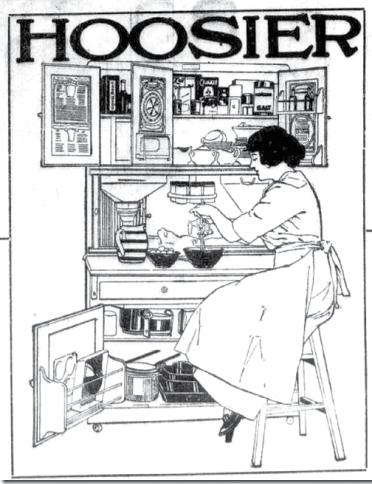
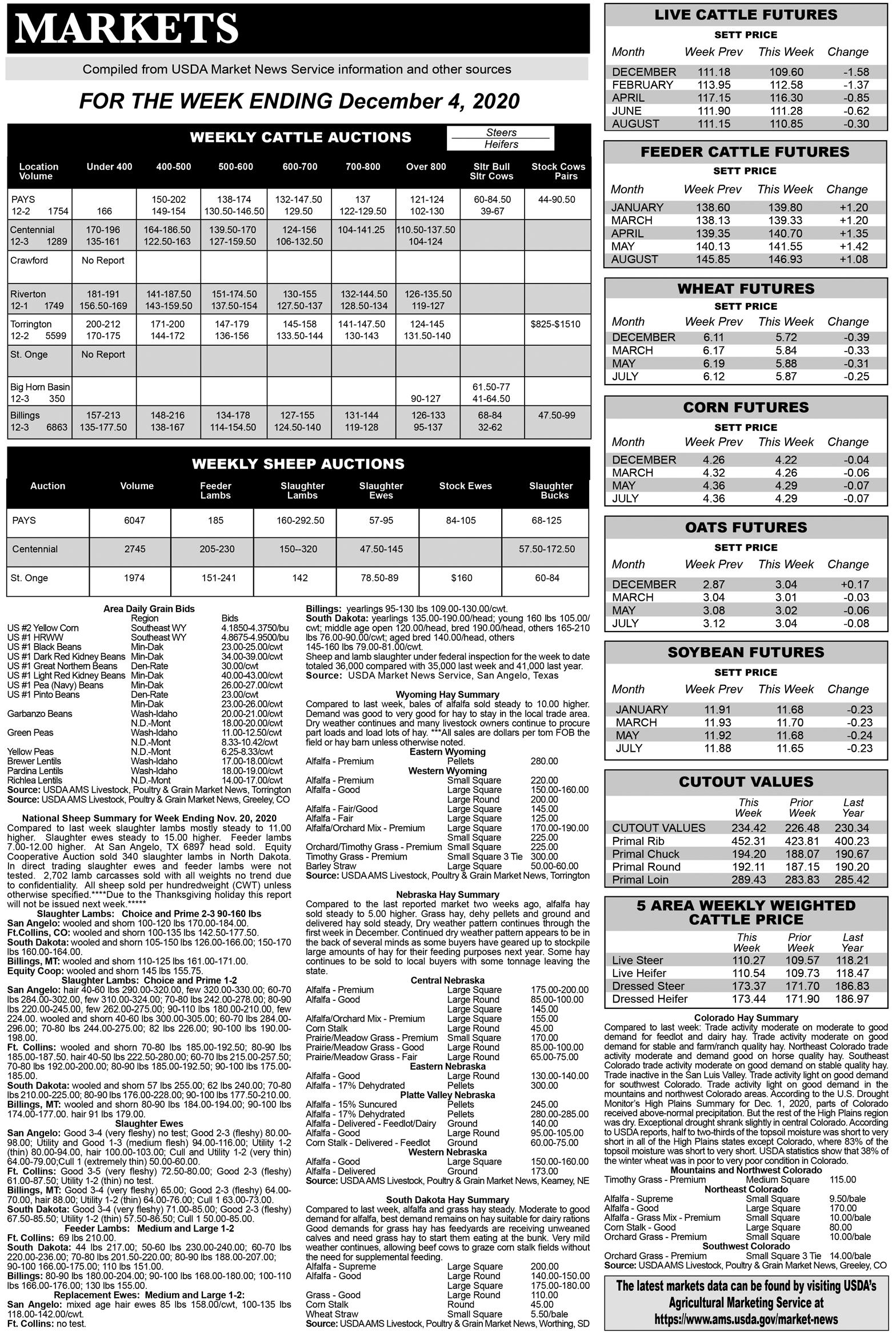
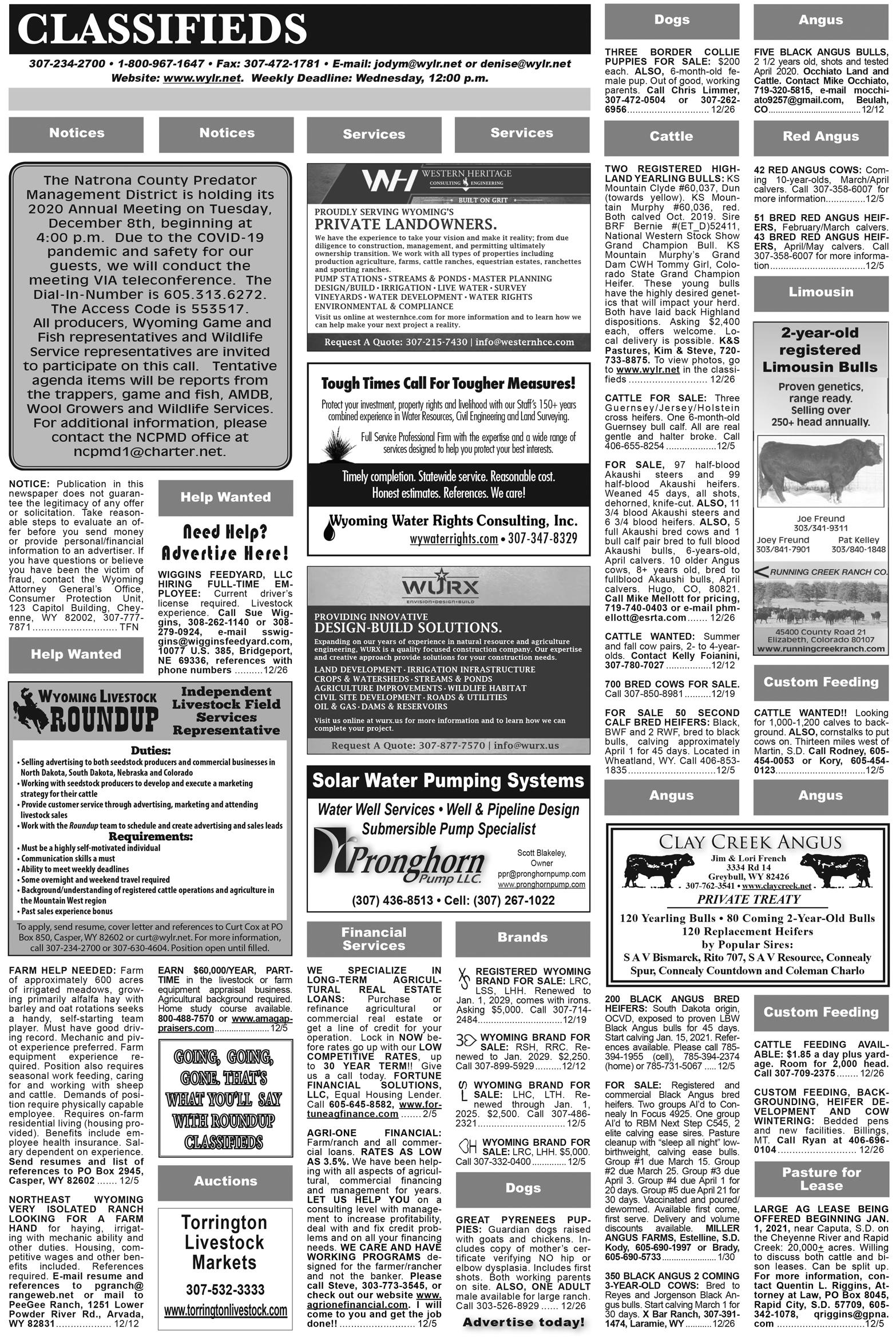
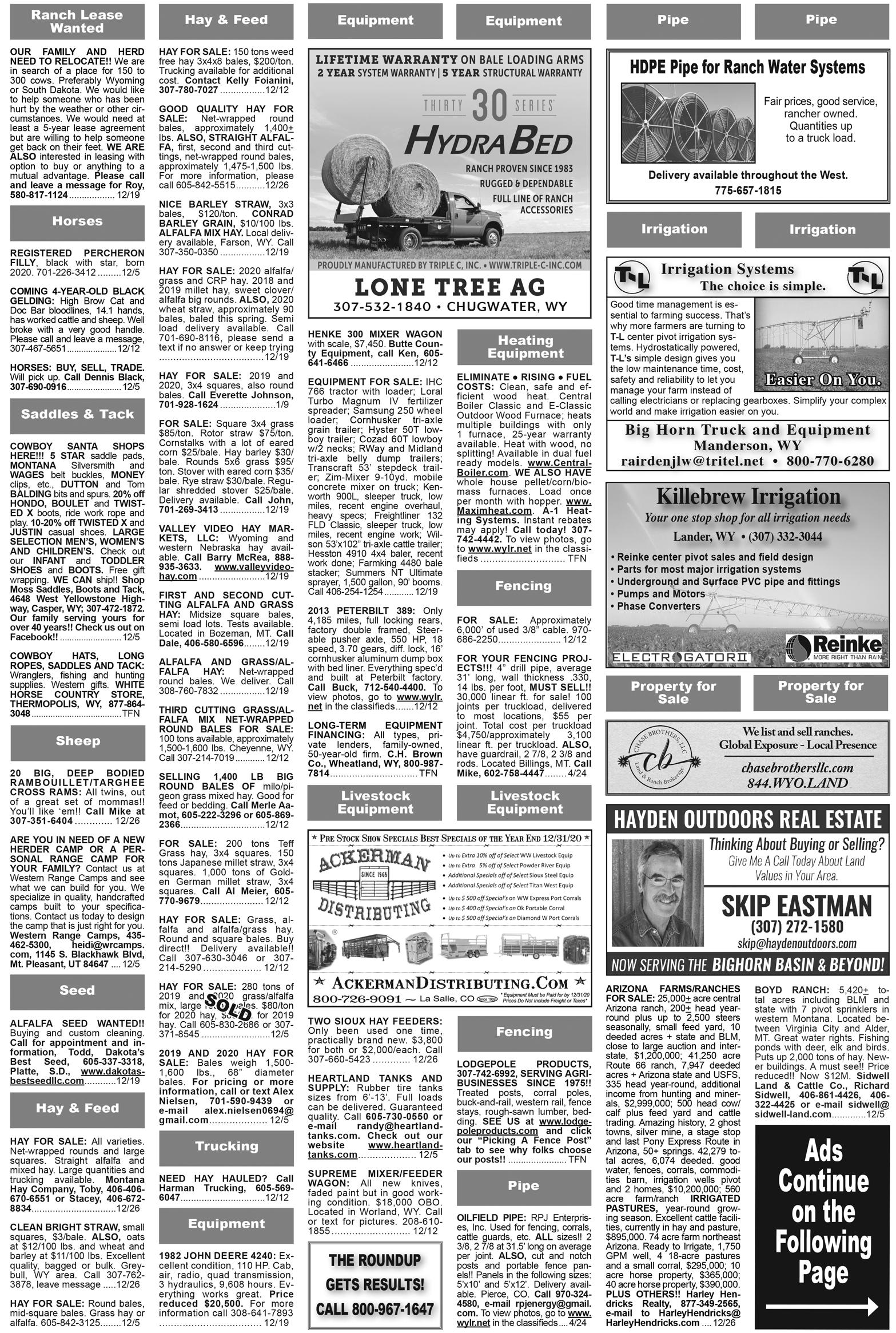
Look back better By Miranda Reiman

One of the largest expenses for most cattle operations comes from harvesting storing and feeding rations during winter months. Whether producers utilize a silage bunk, feed baled forages or swath graze, they will often see losses from spoilage, mold and trampling.
According to the Beef Cattle Research Council (BCRC), if producers take time to make even the slightest improvements to their winter-feeding system, they may see significant savings.
In a recent BCRC newsletter, Prince Edward Island Department of Agriculture Beef Specialist Dr. Les Halliday and Duane McCartney, retired forage-beef systems research scientist at Agric Canada, discuss 11 ways to reduce silage and dry hay waste this winter.
Limiting silage waste
According to Halliday, there are five ways to reduce waste when feeding silage.
The first is using balers with knives.
“Coarse chopping allows for tighter packing of the forage in the bale, resulting in less air and a 10 to 15 percent higher density, meaning less bales to wrap,” he explains, noting chopped grass in baled silage will also undergo a faster and more efficient fermentation process than in regular baled silage.
He also notes it is easier for cattle to eat chopped silage, which results in higher intake and less waste.
The second tip on Halliday’s list is to ensure silage bales are consistent in size and shape when
Sometimes my mom leaves behind boxes of memories at my house. They come in the form of trinkets, pictures and random notebook pages, a few decades old.
Mom has been cleaning closets lately, the results of which provide all kinds of laughs – pictures of 13-year-old me and my friends – and things that catch a little, like the cards I wrote, but never sent, to people who can no longer receive them.
As I recently went through a left-behind tote, I came across a small box of notes no doubt recovered from the deepest of corners.
Always a writer it seems, I even scribbled out letters to myself on occasion. They often detailed exactly how it felt when I encountered some big change in life, such as my best friend moving away in fourth grade or when I faced something that felt really wrapping them in rows.
He explains wrapping bales similar in size will reduce air pockets, which can form when bales aren’t consistent.
“If a producer is looking to cut their costs, it shouldn’t be their plastic,” he says. “The plastic wrap around silage bales creates a barrier from oxygen, which is critical for good silage production. Without proper coverage, even a tiny hole can lead to spoilage.”
Additionally, Halliday recommends utilizing double seal bunks or oxygen barriers, storing chopped silage in a bunker system and maintaining a smooth silage bunk face to reduce secondary spoilage.
“An uneven bunk face, caused by feed removal, can result in a significant amount of air infiltration, which wakes up the microbes that begin to use up nutrients. This leads to carbon dioxide, ammonia and gas production as well as the growth of mold, yeast and certain pathogenic bacteria,” he explains.
Reducing dry hay waste
Similar to silage, McCartney notes reducing the amount of dry hay waste on an operation starts in the field.
“When cutting hay, producers should set their mowers to the widest setting,” McCartney says. monumental – like trying the sport of basketball and pretty quickly finding I was no good at it.
Most of these memories only surfaced now with hidden reminders, but at the time I penned the words? They felt huge. They caused me heartache and angst.
Nobody likes to hear this in the middle of a trial, but it seems often true in life and business – the thing that feels so hard now, won’t always feel hard.
What felt nearly impossible to my juniorhigh self, I wouldn’t think twice about today.
This is the beauty of continued growth. We learn, make improvements and then build on those.
Maybe a producer received their first set of carcass data back and it was just average, but they want to make their herd elite to earn premiums that brighten their bottom line. It feels like there are so many decisions going
Canada “This will enable shorter drying time, lower respiration losses, higher sugar content and more digestible energy. It will also improve the fermentation process and reduce the likelihood of rain damage.”
When storing dry hay, McCartney recommends arranging bales to allow sufficient air flow, which reduces moisture accumulation leading to spoilage loss. He also encourages producers to assess any leftover bales that may need to be rearranged to ensure there is adequate space around all bales.
Additionally, when feeding forages, McCartney says there a few things producers should keep in mind.
“When feeding forages in round bale feeders, producers should ensure each cow has enough space at the feeder to reduce competition and minimize trampled feed,” he says, noting he has observed the least amount of waste when feeding with tapered cone-style round bale feeders.
“Producers should also avoid feeding forages directly on the ground if at all possible,” McCartinto the final report card and balancing all the competing demands is tricky.
Maybe a producer has the best set of calves they’ve ever weaned in front of them, but they’re trying to market them with extra information. It’s a new process that feels more cumbersome than their usual methods.
Growth is uncomfortable. It can be uncertain as the outcome is not guaranteed. It’s flatout hard work, but if we ever take a moment to look back and see how far we’ve come, that’s where the reward is.
I hope producers top the auction or see huge year-over-year improvements in their data. I hope they find solutions to their biggest challenges, so they become mostly distant memories.
I’m still no great talent on the basketball court, but I certainly don’t feel bad about it now, because the next year I found cheerleading. And I kept writing. We never know where our growth might lead us.
Next time in Black Ink®, Miranda Reiman will talk about how we
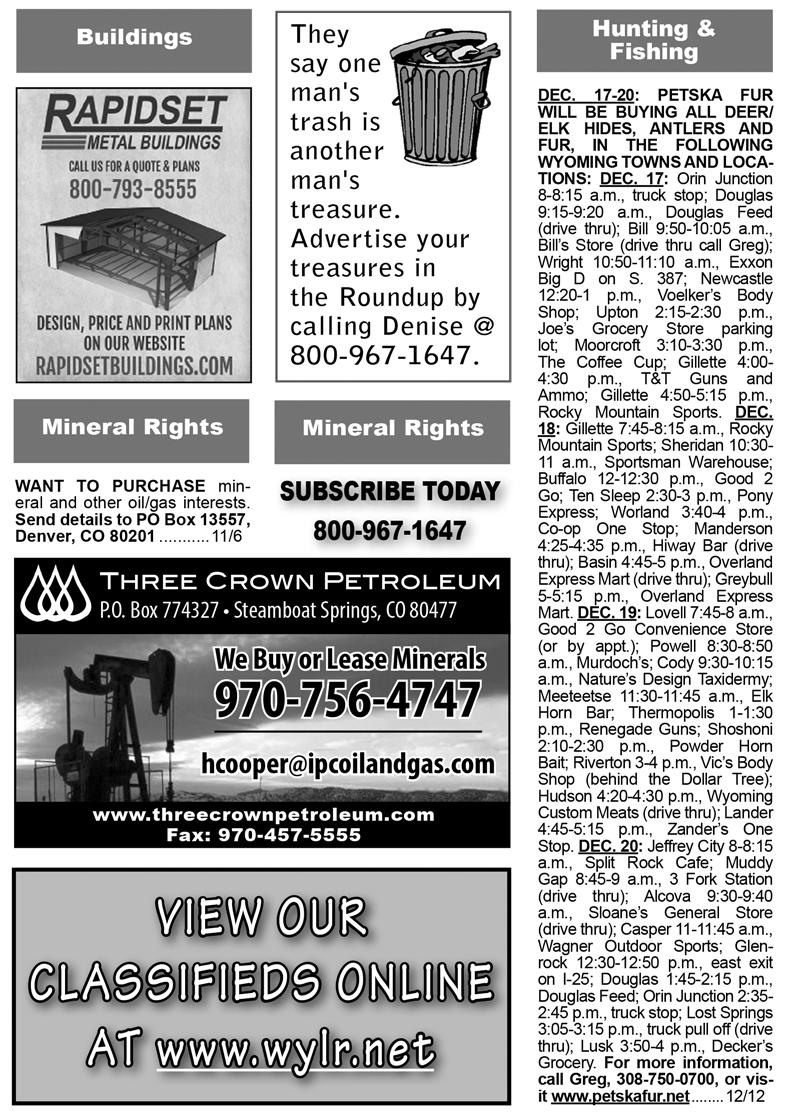
BCRC explains 11 ways to avoid silage and dry feed waste this winter
“Whether it is chopped silage or round bales rolled on to the snow, feed losses can range from 23 to 26 percent.” – Duane McCartney, Agric
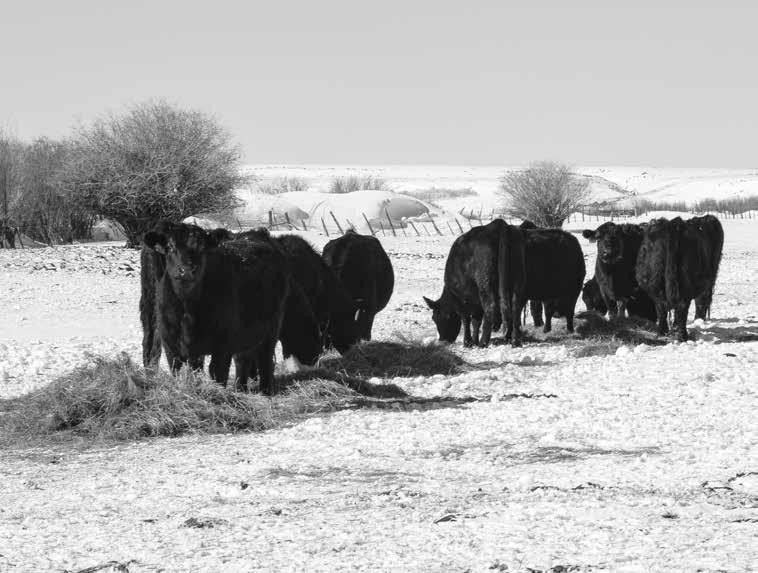
can’t change the past. ney states. “Whether it is chopped silage or round bales rolled on to the snow, feed losses can range from 23 to 26 percent.”
To avoid this, McCartney suggests utilizing a portable feed bunk.
McCartney also notes swath grazing may be an effective practice, although it requires some additional planning.
“Cattle can be fenced into a small section, which can be cleaned up ideally within three days,” he explains. “Not fencing off sections for swath grazing can result in an unbalanced diet and risk of acidosis.”
“Accessibility of swaths also needs to be addressed,” continues Mccartney. “To open up areas in times of heavy snow, a tractor may be driven down the swath or a blade used to move snow off of it. It is also important to provide adequate shelter, either through natural shelter or portable windbreaks, to prevent cattle from bedding down in the feed.”
Hannah Bugas is the managing editor of the Wyoming Livestock Roundup. Send comments on this article to roundup@wylr.net.
Submit your letters to: Editor, Wyoming Livestock Roundup, P.O. Box 850, Casper, WY, 82602, or e-mail to roundup@wylr.net. We reserve the right to edit letters. It is the policy of the Wyoming Livestock Roundup that we do not print letters attacking individuals, groups or organizations within the Wyoming agricultural community.
Dear readers,
My grandfather, Albert Kilber, has been in the horse business for 36 years, from 1984-2020.
In 1984, he bought out Nick Kautzman’s 12 Belgians. He was told they were all two-year-olds, though his neighbors swore they were all four. In 1985, he started to buy Percherons, the first of which came out of South Dakota. Then, he started to travel to Indiana to make his purchases from the Amish.
Grandpa bought from the Amish until 2010 when they switched to raising Belgians for horse pulling contests. He did this because the ranchers who bought his teams preferred Percherons because they travel faster with a load.
Once he got eight Percheron weanlings out of Canada. Another time he bought 15 horses from a gentleman named Ron Nester. Three of these went on to South Dakota, two to Montana, two to Iowa, two to Utah, two to Oregon, one to Colorado and one to Wyoming. One time he sold out all of his teams throughout the western U.S. and had to tell a potential buyer all he had left were four sets of harnesses to sell.
During this time, he also had dairy cattle. He needed a name for his dairy, and he came up with Powerpoint.
Powerpoint came about because at the time he was surrounded by four power-generating sources – Basin Electric, Garrison Dam, Coyote Station and Dakota Gasification. Their farm was right at the center, thus Powerpoint Percherons was born.
I fondly remember the times I spent out at the farm during the summer, watching him break the horses. He would tie them behind the tractor so they had to learn to follow directions. He had a wonderful dog – a Border collie/blue heeler mix named Scooter – who would travel side-to-side to keep the horses in line when they tried to pull back from the tractor.
At times, grandpa would hitch the green ones four abreast and drive them so they would learn. Sometimes he would tie two young ones behind the wagon when we went for wagon rides, and we would grab grass off the roadside and feed them as we went. There was often a turnover of horses, but we didn’t mind, we loved them all and learned their names.
One very memorable occasion, my grandfather and I were calling the horses in from the pasture. Grandpa called out to them in a strange high-pitched voice, “Come, come, come, come!”
And, I asked him why he called like that.
He had replied, “I’m pretending to be grandmother so they come quicker!”
It still makes me laugh.
These times with him are still my favorite memories. We’ve hunted down escaped horses, harnessed and hitched them together, and every summer we drove them out to Pick City and had ice cream at the Crab Apple.
It is with great sadness we announce his retirement from the horse selling business, but it is with great pride we were able to share his legacy and passion with everyone.
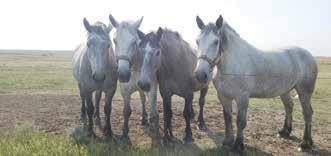
Natasha Hecker Dickinson, N.D.
Vermilion Ranch Fall Performance Sale
Reported By: Curt Cox, WLR Field Editor Nov. 28, 2020 PAYS, Billings, Mont.
Auctioneers: Roger Jacobs, Joe Goggins, Bill Cook, Ty Thompson and Greg Goggins
174 Angus Fall Yearling Bulls Avg. $6,885 116 Two-Year-Old Bulls Avg. $6,580 83 Registered Bred Angus Cows Avg. $3,331 65 Registered Bred Heifers Avg. $3,061 1,364 Commercial Bred Heifers Avg. $1,795 190 Commercial Bred Cows Avg. $1,236
Top Sellers: Bulls
Lot 1 – Vermilion Bomber G756 – Price: $36,000 DOB: 8/10/19 Sire: Casino Bomber N33 Dam’s Sire: Vermilion Madison A872 EPDs: BW: +1.8, WW: +89 YW: +154 and Milk: +25 Buyer: Edwards Livestock, Laramie and Dallas Ranch, Laramie
Lot 3 – Vermilion Bomber G758 – Price: $32,000 DOB: 8/10/19 Sire: Casino Bomber N33 Dam’s Sire: Vermilion Playmaker Y290 EPDs: BW: +1.7, WW: +78, YW: +122 and Milk: +23 Buyer: Clear Creek Angus, Chinook, Mont.
Lot 192 – Vermilion Reride G142 – Price: $21,000 DOB: 2/15/19 Sire: Vermilion Re-Ride Dam’s Sire: Connealy Countdown EPDs: BW: +2.9, WW: +72, YW: +120 and Milk: +20 Buyer: Camas Prairie Angus Ranch, Grangeville, Idaho
Lot 191 – Vermilion D125 Spur G270 – Price: $19,500 DOB: 3/17/19 Sire: Vermilion Spur D125 Dam’s Sire: FF Dempsey Y11 EPDs: BW: +2.9, WW: +88, YW: +145 and Milk: +21 Buyer: ABS Global, DeForest, Wis.
Lot 27 – Vermilion Quarterback G769 – Price: $17,000 DOB: 8/15/19 Sire: S A V Quarterback 7933 Dam’s Sire: Sitz JLS Game Day 9630 EPDs: BW: +1.7, WW: +90, YW: +151 and Milk: +28 Buyer: Whittkopp Angus, Circle, Mont.
Registered Bred Cow
Lot 331 – Vermilion Elba 3068 – Price: $22,000 DOB: 2/4/13 Sire: Sitz JLS Game Day 9630 Dam’s Sire: Connealy Gold EPDs: BW: +1.5, WW: +83, YW: +138 and Milk: +15 Buyer: Jeff Burger, Williston, N.D.
Lot 344 – Vermilion Lass 3236 – Price: $13,500 DOB: 3/5/13 Sire: Hilltop Fergus 0303 Dam’s Sire: Connealy Danny Boy EPDs: BW: +1.5, WW: +50, YW: +95 and Milk: +24 Buyer: Jeff Burger, Williston, N.D.
Lot 387 – Vermilion Blackbird 7142 – Price: $10,000 DOB: 2/12/17 Sire: Connealy Spur Dam’s Sire: D R Sierra Cut 7404 EPDs: BW: +4.1, WW: +74, YW: +125 and Milk: +230 Buyer: Camas Prairie Angus Ranch, Grangeville, Idaho
Registered Bred Heifer
Lot 469 – Vermilion Blackbird 9611 – Price: $6,000 DOB: 3/24/19 Sire: Vermilion Spur D114 Dam’s Sire: Vermilion Boss A211 EPDs: BW: -0.3, WW: +58, YW: +109 and Milk: +21 Buyer: Mahar Cattle Company, Timberlake, S.D.
Reported By: Curt Cox, WLR Field Editor Nov. 24, 2020 Paint Rock Angus Ranch, Hyattville
Auctioneer: Joe Goggins
106 Bull Calves Avg. $5,106
Top Sellers:
Lot 8 – Paintrock Motive 98-J20-0 – Price: $11,000 DOB: 1/16/20 Sire: Paintrock Motive 98-8 Dam’s Sire: Hartz Quality Product 42 EPDs: BW: +0.6, WW: +47, YW: +83 and Milk: +23 Buyer: Bob Stoddard, Newcastle
Lot 4 – Paintrock Motive J11-0 – Price: $10,000 DOB: 1/24/20 Sire: PRA Motive 501 Dam’s Sire: Sitz Timeline 7734 EPDs: BW: +1.2, WW: +56, YW: +97 and Milk: +23 Buyer: Bob Stoddard, Newcastle
Lot 62 – Paintrock Trapper 364-0 – Price: $10,000 DOB: 2/11/20 Sire: Paintrock Trapper Dam’s Sire: Paintrock New Design 208-975 EPDs: BW: +0.5, WW: +52, YW: +81 and Milk: +31 Buyer: Bob Stoddard, Newcastle
Lot 15 – Paintrock Rainmaker 98-0 – Price: $9,500 DOB: 1/28/20 Sire: Basin Rainmaker 4404 Dam’s Sire: Three Trees Prime Cut 0145 EPDs: BW: -0.2, WW: +51, YW: +87 and Milk: +23 Buyer: Mark Johnson, Laramie
Lot 2 – Paintrock Brokenbow 904-0 – Price: $8,500 DOB: 1/15/20 Sire: KM Broken Bow 002 Dam’s Sire: Paintrock Trapper EPDs: BW: +0.9, WW: +66, YW: +101 and Milk: +27 Buyer: Hunter Cattle Co., Edgemont, S.D. and Gale Marx, Rushville, Neb.
Lot 6 – Paintrock Motive 589-0 – Price: $8,500 DOB: 1/17/20 Sire: PRA Motive 501 Dam’s Sire: Mytty In Focus EPDs: BW: +1.1, WW: +57, YW: +98 and Milk: +25 Buyer: Bob Stoddard, Newcastle
Lot 17 – Paintrock Charm 258-0 – Price: $8,500 DOB: 1/20/20 Sire: BUBS Southern Charm AA31 Dam’s Sire: Paintrock Coal Bank 366-2 EPDs: BW: +1.9, WW: +51, YW: +91 and Milk: +25 Buyer: Merlin Ranch, Buffalo
CAC applications open
The 84th year of the National Western Stock Show (NWSS) Catch-a-Calf Program (CAC) is approaching in 2021. While the National Western Stock Show is postponed for 2021, the process of acquiring participants for next year’s program continues.
Due to the circumstances there will not be catches held during the rodeo, as in previous years. However, a draw of applicants will be held to select the 40 participants who will return in May to receive their project.
Youth selected for the CAC are then required to feed and care for their steer until the 2022 NWSS. Participants must also submit a record book, participate in an interview and compete in showmanship.
The overall grand and reserve grand champion Catch-aCalf steers are eligible for the Auction of Junior Livestock Champions. The program is open to 4-H members from Colorado, Wyoming, Kansas and Nebraska between 12 and 18 years of age, as of Dec. 31, 2020.
The online application can be found at nationalwestern. com/catch-a-calf-program/. Corresponding forms and the online application are due by Jan. 15, 2021.
Courtesy photo
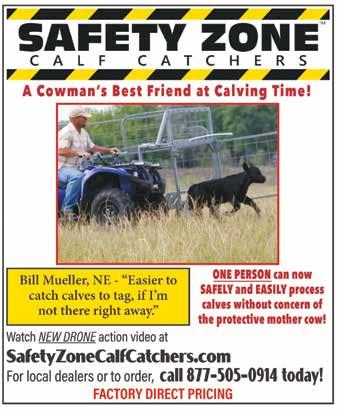
Rick Griffith
Regional Vice President
Esther Clark
Financial Officer
Julie Volker
Financial Officer
Irv Bard
Financial Services Officer
Leah LaRocca
Financial Services Officer
Garrett Horton
Financial Services Officer
from our team to you and yours warmest wishes for a happy holiday season.


